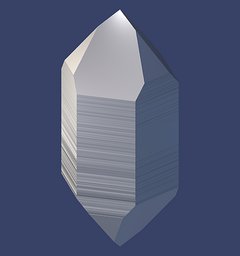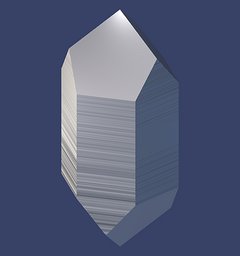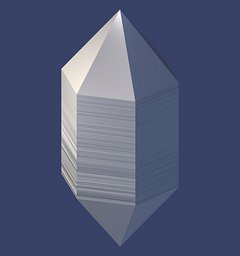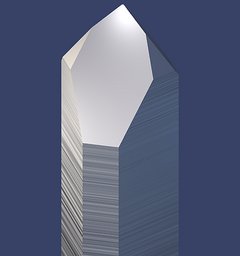last modified: Saturday, 21-Jan-2012 03:54:17 CET
Document status: usable, incomplete, images missing
Just as the faces which a crystal develops depend on the physical and chemical environment, the overall shape - the habit of a crystal reflects the individual growth conditions. Some minerals, calcite is probably the best example, develop completely different forms and habits in different environments, but quartz is rather stubborn and will rarely assume shapes that differ greatly from a typical crystal. Although some studies tried to correlate certain growth conditions with habits and growth forms and although one can see similar crystal shapes and growth forms in similar environments, the determining factors for many habits are not clear yet and I don't know of any systematic and comprehensive study of these relationships.
The
geochemical and physical conditions often change during growth, but it's usually difficult to find out if the crystal's overall shape changed during growth without using destructive methods. The image shows a rare exception, a specimen that is also presented in the
Growth Forms section. It is a slighly smoky crystal with a green chlorite phantom that reveals that the crystal's shape changed from a
Muzo habit to a
normal habit during growth. The hourglass-shaped dark green patch is made of a small r-face on top and a larger m-face at the bottom (compare to this
Muzo habit crystal shown below). From Cerra Do Cabral, Minas Gerais, Brazil.
Normal Habit or Prismatic Habit
Crystals that show well developed r and z rhombohedral faces and the hexagonal prism and that do not deviate too much from the "ideal" form are sometimes referred to as showing a "prismatic" or "normal habit". In Switzerland this habit is sometimes called
Maderan habit ("Maderaner Habitus", after the Maderan valley, Aar Massive, in the Kanton Uri, Switzerland).
This
is a very nice example of a normal habit smoky quartz as it is found in the southern Aar Massive of central Switzerland. From the Feldschijen, Turm I (first tower of Feldschijen mountain), Göschenen, Uri, Switzerland.
Trigonal Habit
The term "trigonal" stands for a threefold rotational symmetry (as opposed to a sixfold symmetry of hexagonal crystals). Although quartz is trigonal by itself, certain crystal shapes make this more obvious. The most common trigonal habit is one where crystals lack z rhombohedral faces. The rhombohedral z-faces generally tend to be smaller than r-faces, and sometimes they are completely absent. Amethyst from geodes in basalt often lacks z-faces. Needle quartz often shows a trigonal habit, too.
Other habits with an obvious trigonal symmetry are the Muzo habit and the cubic habit.
Hexagonal or Pseudohexagonal Habit
In certain twinned crystals r and z rhombohedral faces cannot be distinguished, and as the speed of growth of the rhombohedral faces does not differ, the crystals show a hexagonal shape.
A
smoky quartz crystal of almost ideally developed pseudohexagonal habit, from Switzerland, probably the Aare massif. The reason for the pseudohexagonal habit is likely Dauphiné law twinning, although nothing on the crystal indicates any twinning (the visible steps on the faces are sutures and have nothing to do with twinning). Collection of the Spirifer Geological Society, Poland.
Impurities
interfere with crystal growth and quartz crystals with a lot of inclusions are often twinned. Thus milky quartz or ferruginous quartz quite commonly show a hexagonal habit.
These intergrown double terminated milky quartz crystals are examples of the famous
Suttrop type quartz, named after the village of Suttrop near Warstein in the Sauerland. This specimen is from Hohenlimburg-Oege, Hagen, however. More about this specimen can be read at the
Milky Quartz subsection.
Pseudohexagonal crystals that have very small m prism faces or lack the m-faces altogether are said to show a
Cumberland habit, named after the location in Egremont, Cumbria (a.k.a. Cumberland), in Northern England. The shiny quartz crystals grow on botryoidal and platy hematite and are usually colorless, but can also be deeply orange due to included iron oxides.
This
small crystal hasn't developed any prism faces and serves as an example for the cumberland habit. It has weathered out of silica-rich marine sediments at Monte Acuto Ragazza, south of Bologna, Italy, a location that is well known for this type of crystals. The crystal contains dark inclusions of magnetite. Smaller cumberland habit crystals sit on it and those that fell off have left indentations on its surface.
The crystals are often labeled as "high quartz" or "β-quartz", because they resemble crystals that initially formed as the high-temperature polymorph beta-quartz. After the temperature falls, the outer shape is preserved in the "ordinary" (low-temperature polymorph) quartz.
This is one way of explaining the habit, but I have some doubts that the crystals really started as high quartz. The problem is that at temperatures above about 500°C quartz and the calcite or dolomite present in the sedimentary rocks slowly start to react to form new minerals like tremolite, wollastonite, or talk, so depending on the local conditions, quartz might not be stable at these temperatures. The inversion temperature from low- to high-quartz is 573°C at normal pressure and will be even higher at higher pressures. If the rock is very dry and the quartz crystals are already present, the crystals might withstand corrosion for a long time, but they would definitely not grow under such conditions. An Italian geologist has confirmed to me that the grade of metamorphosis is very low at the location, so these temperatures have never been reached, and had they been reached, there would probably be no crystals. The fact that there are magnetite inclusions present in the crystals seems to indicate higher temperatures, as magnetite is typically found in igneous and metamorphic rocks and in skarn zones. However, it is completely in line with the common diagenetical formation of magnetite in sedimentary rocks under reducing conditions.
This
is the "original", quartz with with Cumberland habit and "specularite" hematite on a hematite matrix from Cumberland. Unfortunately it is difficult to see the characteristic habit on this specimen because the crystals are intergrown, but if you check the large versions, there are really no m-faces at all. From the Beckermet Mine, Egremont, Cumbria, United Kingdom.
Needle Quartz
Needle quartz is simply the name for very elongated quartz crystals with a needle-like look. Crystals on a specimen tend to be of comparable size, and often they are oriented in parallel or radiate from a common point. Needle quartz is usually colorless, smoky needle quartz is rare, and amethyst-colored needle quartz does apparetly not occur. Most needle quartz exhibits a trigonal habit with small or absent z-faces, and Dauphiné habit is also very common. Needle quartz typically has grown quickly at relatively low temperatures. Quick growth is caused by quickly falling temperatures and/or pressures, indicating a tectonically active environment or rising brines that cooled quickly.
The
specimen to the right is from the Val Bedretto, Ticino, Switzerland, a classical location for needle quartz.
Most of the crystals on this specimen have developed a Dauphiné habit with one of the rhombohedral faces enlarged. The large illuminated face of the central crystal shows a stair step of a prism face, something which can be frequently seen on needle quartz.
Needle
quartz has grown in a pocket inside an epidote rock. It is very faintly colored green, probably by finely distributed epidote at its base. Like in many needle quartz specimens, the crystals lack z-faces and their tips show a trigonal habit. Between the crystals there are numerous very thin shiny fibers of an unknown mineral that also run through the quartz crystals. From Rahjerd village, Markazi Province, Iran, a source of fine epidote crystals.
Dauphiné Habit
Quartz crystals with a Dauphiné habit have one or two greatly enlarged rhombohedral faces. The habit is named after the
Dauphiné, the old name for the French Alps around Grenoble. The Dauphiné habit should not be confused with the
Dauphiné twin.
In general faces are large because they grew slower than the other faces on the crystal. This unequal development of crystal faces can have a number of causes:
- an uneven supply of silicic acid molecules during growth because of fluid currents in the watery solution
- an uneven supply of silicic acid molecules during growth because of surrounding crystals hindering the diffusion of molecules
- fine material (pocket detritus) that precipitates on one side of the crystal due to gravitation. Usually this will promote growth.
That pocket detritus on a crystal can facilitate growth is somewhat counter-intuitive and needs an explanation. One would expect that it hinders growth because it covers parts of the crystal's surface. If enough material precipitates, this is in fact the case, and the type of detritus can also determine if the crystal growth is promoted or inhibited. But if the detritus is very fine it will primarily disturb the surface structure of the crystal and cause defects in the crystal lattice. These lattice defects are thermodynamically instable and are starting points for the addition of more ions, or, in the case of quartz, molecules of silicic acid. So if there is a more or less constant supply of a small amount of fine material precipitating on one side of the crystal, that side will grow faster. If you have a look at a number of Dauphiné habit crystals, you will note that often the faces on the "front side" (the side of the big rhombohedral face) are shiny, while the faces on the opposite side are a bit dull or rough, reflecting the disturbances during growth. Often you can even see some of the precipitated material, sometimes drawing a faint phantom of the former crystal's shape. The molecules of silicic acid are too small and too light to settle in watery solutions at temperatures between 100°C and 450°C, so in a pure solution gravitation has only little influence on the shape of quartz crystals.
Because of the influence of gravitation on the shape of the crystal, on specimen with several crystals of Dauphiné habit, the large rhombohedral faces normally point roughly in the same direction. In needle quartz, which often develops a Dauphiné habit, this orientation preference is not that obvious.
Slow growing clear crystals with a macromosaic crystal structure do usually not show a pronounced Dauphiné habit, and Tessin habit crystals (typically slowly grown crystals) apparently never show a Dauphiné habit. One should be careful not to generalize to quickly, though, as the line between Dauphiné habit and non-Dauphiné habit is not very well defined.
The
specimen to the right was labeled as being from Grenoble. Probably it is from the vicinity of a classical locality 50km south-east of Grenoble: the old gold mine La Gardette, at Villard Notre-Dame, south of Bourg D'Oisans, that has also been exploited for its exceptionally clear rock crystals since the early 18th century.
The
second image shows a rock crystal with Dauphiné habit from Brazil.
A
rule is not a law. The fact that material gets precipitated on one side of a crystal does not necessarily cause the development of a Dauphiné habit. These smoky quartz crystals carry numerous small crystals and crystal fragments on their left side, yet they show a normal habit. If this has to do with the fact that the surface of prism shows
split growth patterns is an open question, but so far I have never seen a quartz crystal with split growth, either as artichoke or sprouting quartz, and a well-defined Dauphiné habit. From Sørli, Nord-Trøndelag, Norway. The same specimen is shown with a diferent perspective in the
smoky quartz chapter.
Tessin Habit
A crystal whose hexagonal prism gets continuously thinner towards the tip of the crystal by alternating
steep rhombohedral and
m prism faces is said to have a Tessin habit (named after the Swiss Kanton Ticino/Tessin). Because this habit occurs in the penninic part of the Alps, it's also called
Penninic habit.
Quartz with a Tessin habit seems to have formed at high temperatures (around 500°C) in fluids that are rich in carbon dioxide, CO2. Often Tessin habit crystals show a macromosaic crystal structure that is indicative of slow growth. Tessin habit crystals may also show a lamellar structure, then often with a more trigonal habit.
The
first image shows a rock crystal from the Turbealp, Binntal, Wallis. The rhombohedral faces on Tessin habit crystals typically are very small, simply because the tip is very narrow. The crystal has a nice striation on its steep rhombohedral faces, similar to the one usually seen on m-faces.
The
rock crystal in the second image is from the Binntal, as well, but from the Fäldbachtal. Its steep rhombohedra have a much more irregular surface structure, in part because of growth inhibiting crystals of other minerals, like calcite, that later were dissolved, in part because its macromosaic structure is more visible. The rhombohedral faces are much larger than those of the former specimen.
Morion
in Tessin habit, as shown in the third image, is not so common. Among the few Alpine locations is the mountain Rüscada, in Ticino (germ. Tessin), and the Ofenhorn area in the Binntal valley, Wallis, both in Switzerland, as well as the Zillertal Alps, the Ober- and the Untersulzbachtal, all three in Austria. The crystal in the image has a parquet-like surface structure with many sutures, an indication of a macromosaic internal structure. It is from Drammen, Norway.
A
crystal
with a Tessin habit or a transitional habit that is very wide and/or flat and that shows relatively large rhombohedral faces is sometimes called a
Binntal habit by the locals in Binntal valley, Wallis, Switzerland. Such crystals can frequently be found in Bündnerschiefer mica schists in the northern and eastern part of the Binntal valley. The term is not very well defined, however, and is also used as a synonym for Tessin habit.
The image shows a rock crystal from the Turbealp in the eastern Binntal.
Transitional Habit
"Transitional Habit" is the literal translation of the German term "Übergangshabitus". It stands for crystals that show a combination of steep rhombohedral faces that are typical for the Tessin habit and m prism faces common in normal habit crystals, so it is an intermediate between Tessin and normal habits. Crystals with a transitional habit often show a large number of different crystallographic forms, as trapezohedral, pyramidal, and steep rhombohedral faces.
A
rock crystal with transitional habit from the Turbealp in the eastern Binntal, Wallis, Switzerland The steep rhombohedral face can best be seen left to and below a shiny x-face.
A
small rock crystal with transitional habit from a alpinotype vug in gneiss, between Mittlebärg and Tälli glacier in the eastern Binntal valley. The entire left, shiny prism face is a steep rhombohedral face, whereas the steep rhombohedra on the right prism is interrupted by m-faces. The striation visible on the right side is caused by quickly alternating m-faces and steep rhombohedra.
A
smoky quartz crystal from the eastern Binntal, Wallis, Switzerland. It is stubby, barrel-shaped crystal with a transitional habit.
Muzo Habit
In a crystal with Muzo habit the
m prism faces under the
z rhombohedra get replaced by a prism consisting of alternating
z and
m faces. In extreme cases the result is a crystal that does not show six but only three very steep prism faces. The cross section of the upper part of such crystals can be perfectly triangular, while the lower part of the crystals usually remains six-sided. The striation on the prism faces caused by the alternating types of faces can be well visible but also almost absent.
The Muzo habit looks a bit like a very trigonal Tessin habit, but in those the m faces alternate with steep rhombohedral faces, not the r or z faces.
This habit has first been described by Gansser (1963) on crystals from alpine-type fissures in shales of Cretacean age near the village Muzo (more famous for its emerald deposits) in Colombia, but has also been found on rock crystals from pegmatites in Minas Gerais, Brazil, and alpine-type fissures in Switzerland.
This
is an ideally formed Muzo habit crystal that completely lacks the prism faces under its
r faces. Under the
z faces at the tips one can see interspersed steps of more
z faces on the prism.
As you can see at the central shiny face at the tip of the crystal, the r faces become rhomb-shaped, and instead of prism faces we find jagged edges under them.
The crystal is perfectly clear but has a roughened, naturally etched surface. The triangular patches you see at its base are Brazil twin domains. The crystal is from Joaquim Felício, Minas Gerais, Brazil.
This
is a more typical example of Muzo habit crystals. In the lower part of the crystal the
m prism face under the
r rhombohedral face is still visible. Towards the tip, as more and more steps of rhombohedral faces appear on the neighboring prism faces, these get more inclined to the center, and as a result the central face finally disappears. This rock crystal is from the same mine at Joaquim Felício as the one in the former image.
Cubic or Pseudocubic Habit, Cube Quartz or "Würfelquarz"
If the crystal is dominated by the r-faces, and z and m (prism) faces are almost absent, the shape of the crystal is almost that of a r rhombohedral form. The angles of this rhombohedron differ only very little from that of a perfect cube (85.2° and 94.8°, respectively), so the crystal has an almost cubic look, the habit is called pseudocubic. The German name "Würfelquarz" translates to "dice quartz". Quartz with pseudocubic habit is very rare. Ferruginous quartz from a historic mine in the Sauerland, Germany, sometimes formed small "cubes" of just a few millimeters in size. Some transparent and smoky pseudocubic crystals with large r- and very small z-faces came from pegmatites in Ambatondrazaka, Madagascar. Another location is Val Trebbia, Italy, as reported on
www.faden.it.
This
is a very nice example of a pseudocubic quartz crystal, with large r-faces and small z- and m-faces. It is actually a so-called "Pecos Diamond"; these are
authigenic quartz crystals that are found along the Pecos River valley inside and weathered out of a selenite rock matrix of the Permian Seven Rivers formation in south-eastern New Mexico (
Albright and Lueth, 2003). This particular crystal is from Artesia, Eddie County, a location that is known for occasional finds of pseudocubic quartz crystals (
Tarr and Lonsdale, 1929). Donated by John Kashuba.
A
straight view onto an r-face of the same specimen. Since the angles between the faces of the, main rhombohedra r and z are not 90° but 85.2° and 94.8°, respectively, the "cube" appears slightly skewed. The tip of the crystal is the upper left corner.
 Printer Friendly Version
Printer Friendly Version
Copyright © 2005-2013, A.C. A k h a v a n
Impressum
- Source: http://www.quartzpage.de/crs_habits.html






























 Printer Friendly Version
Printer Friendly Version
